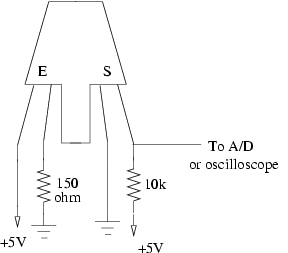Difference between revisions of "Sensors & Circuits"
From CCRMA Wiki
(→Reflective Optical Sensor) |
(→Reflective Optical Sensor) |
||
| Line 8: | Line 8: | ||
===Reflective Optical Sensor=== | ===Reflective Optical Sensor=== | ||
| + | |||
| + | The reflective optical sensor ( Datasheet ) consists of an infrared LED, labelled "E" for Emitter on the diagrand and on the package, and a phototransistor that passes an amount of current proportional to the reflected light received. The phototransistor is labelled "S" for Sensor. The one leg of the sensor is connected to +5V, which supplies current, and the voltage drop across the 10k resistor that we measure is proportional to the amount of current. | ||
| + | |||
| + | There is a continuous voltage response for objects over a short range of proximity to the sensor. The response is not linear. Linearity can be approximated by the log of the log of the signal. | ||
| + | |||
| + | <center> | ||
[[Image:optical.png]] | [[Image:optical.png]] | ||
| + | </center> | ||
Revision as of 21:07, 25 June 2007
Hall Effect
Mulitplexing
IR Distance
Sharp
Reflective Optical Sensor
The reflective optical sensor ( Datasheet ) consists of an infrared LED, labelled "E" for Emitter on the diagrand and on the package, and a phototransistor that passes an amount of current proportional to the reflected light received. The phototransistor is labelled "S" for Sensor. The one leg of the sensor is connected to +5V, which supplies current, and the voltage drop across the 10k resistor that we measure is proportional to the amount of current.
There is a continuous voltage response for objects over a short range of proximity to the sensor. The response is not linear. Linearity can be approximated by the log of the log of the signal.
